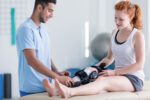Parents Guide To Managing Fall Sports Injuries

Practices for High School Fall sports are finally back in full swing again. This is often the time when tweaks, aches or sports injuries can begin and nag a student athlete all season. What’s worse, they could even suffer a season ending injury. No parent would want their student athlete to miss out on their sport, especially after working so hard for it.
You can help your student athlete prepare for success by understanding some basics about sports injuries. As a parent, knowing how these sports injuries are addressed can make all the difference toward your child having a successful season or watching from the sideline. For more in depth information including Tip Sheets for Managing Sport Specific Injuries, go to www.PlayBetterWithPT.com

Strains and Sprains are the most common sports injuries that student athletes are most susceptible to, especially early in the season. Strains affect muscles and tendons while sprains are injuries to the ligaments in the joints. Injury to either of these tissues is caused by excessive load beyond a body’s tolerance. Student Athletes are most susceptible to these injuries in the pre-season as their bodies have not yet been able to accommodate the heightened level of demand and increased frequency of practices. Further, from a coaching perspective, managing intensity levels of practices for an entire team of varied age high school age athletes (15-18) whose bodies are at different rates of growth and internal demand can be challenging. This is where an individual athlete assessment by a physical therapist can be so valuable.
Strains are common in the low back, hip flexors, groin, hamstrings, quadriceps, just below the knee cap as well as in the calf / Achilles. Strains can occur suddenly, but it is actually often created over time due repeated microtrauma on a muscle or tendon. The location of the pain is not necessarily what is causing the problem, but the result of overuse due to compensation or weakness somewhere else.
Sprains tend to occur more suddenly. This is when the ligaments that keep a joint aligned cannot endure a quick movement and/or are overstretched. The muscles in charge of that joint were too slow to react, causing the ligaments to be vulnerable. Sprains, like strains, can be partial or complete. They typically have swelling around a joint. Sprains are often seen at the knee ie. ACL, MCL, the lateral ankle, the wrist and elbow.

Tips For Managing Sports Injuries, Strains And Sprains:
- Ice the injured area 2-3 x per day with a conforming ice pack wrapped in a pillowcase to protect the skin. Also provide some compression.
- Relative Rest when possible. This means modifying training to allow other muscles to still exercise and joints to move, but protecting the injured area.
- Don’t stretch it! When athletes pull a muscle (another name for strain) for some reason they all want to stretch it out. This is the opposite of what should happen as the pulled muscle is a form of being overstretched. Stretching further, can further injure.
- Provide support. K-Tape, Rock Tape, Sports Tape can provide customized support to connective tissue that has been injured and provide a better environment for healing. Consult a professional about taping techniques.
- Sleep is imperative: Part of any good training / recovery program is attention to quality sleep. True deep sleep is when your body produces its own growth hormone which is required for tissue repair and recovery and growing bodies.
- Anti inflammatories may inhibit the recovery. Inflammation is a natural progression the body uses to set up for healing. Anti-inflammatories can disrupt this healing process.
- Your choice…Miss playing time now or miss it later for longer? When recovering from an injury sometimes there is no substitute for a true break from practices / games. Injured athletes should think strategically about taking time off early on when the injury is minor vs. being forced to sit when the big game comes later in the season.
- Prevention is always best. There is good research on sports injury prevention programs, especially for the knee. Register for a Free Sports Performance / Injury Prevention Assessment. This will help your student athlete to safely stay in the game and ahead of the competition.
For more information about caring for sport specific sports injuries and getting a Sports Performance / Injury Prevention Assessment program, go to www.PlayBetterWithPT.com.
